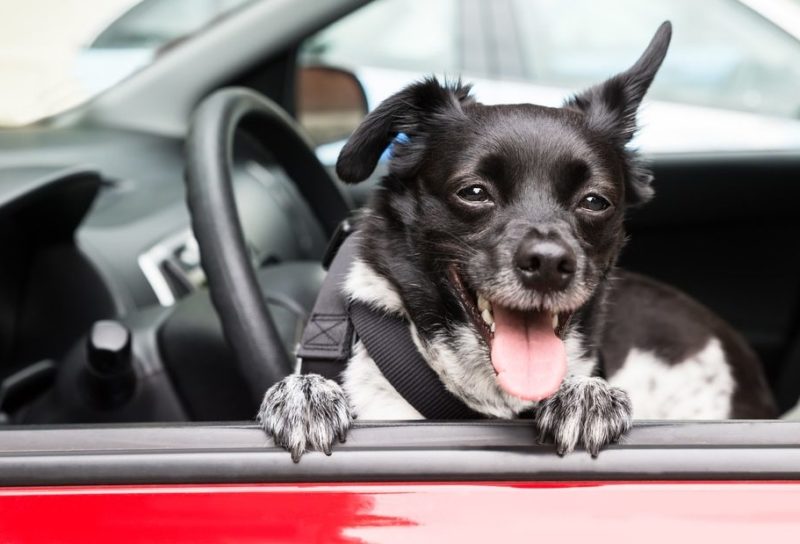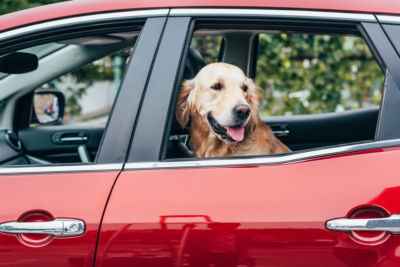 It’s a common experience to need to relocate your dog along with the rest of the family during a move. Many pet owners also like to take their dogs with them on road trips and vacations.
It’s a common experience to need to relocate your dog along with the rest of the family during a move. Many pet owners also like to take their dogs with them on road trips and vacations.
The tricky part is that cars are designed with human safety in mind, not canine safety. So it takes some extra precautions to safely transport your dog in the car.
Safe Travel With Your Dog in the Car: Dos and Don’ts
Let’s review some of the common dos and don’ts for canine safety during car journeys. Whether it’s a short drive or a cross-country trek, there are certain things you should always keep in mind.
Do: Use Crash-Tested Crates
The safest way to transport your dog in the car is to use a safety-certified, crash-tested crate or pet carrier. Fiberglass-reinforced plastic and aluminum are the preferred materials, and you should make sure the crate is size-appropriate for your dog.
The crate should be insulated and have good air circulation. Look for reputable brands that offer at least a two-year warranty and have strict guidelines for quality.
You can tie the crate down for an added level of security and install crash bags inside it to keep your canine family member from being knocked around inside the crate during an accident.
Don’t: Let Your Dog Run Freely in the Car
The biggest don’t for dog travel is having your canine loose in the car. Aside from the potential for them to distract the driver, they can be at severe risk of injury in an accident. Even if they avoid such injury, panicked dogs have been known to flee after an accident and get hit by traffic.
There can be a temptation to let your dog stick their head out the window, but avoid it: Overexcited dogs have been known to jump out through windows, and the wind is bad for their eyes.
Do: Consider a Dog Barrier… But Consider its Limitations
Barriers between the front and back seats of the car, or between the back seats and the car’s cargo area, will keep dogs from being thrown forward in the event of an accident.
They provide more freedom of movement, although if you’re keeping your dog in the car back seat you’ll want to disable your power windows to keep them from accidentally opening something at the touch of a paw.
What barriers don’t do is prevent dogs from escaping if the back door or trunk of the car is left open by an accident.
They also don’t provide much protection for dogs during a crash beyond keeping them from being thrown into the front seat or windshield. That makes them a partial solution, better than nothing but not an improvement on a high-quality crash-tested crate.
Don’t: Use Non-CPS-Certified Dog Chairs or Harnesses
Dog safety harnesses for car travel can be very inconsistent products. There are a few products certified by the Center for Pet Safety as providing real security for dogs designed around the way their bodies work.
These products are dog safe and have been actually crash-tested and shown to function. Keep in mind that even then, they’ll work best for small to medium-sized dog in the car.
Few cars are large enough, harness or not, to keep large dogs out of contact with the front seat and the injuries that can result from a crash.
There are plenty of harness products sold at big-box pet stores and chains, often designed as accessories to your car’s existing seat belts. Many claim to be “safety-certified” but in fact fail in actual crash-testing.
These products provide a false sense of security, and it’s best to avoid any harness that hasn’t been CPS-certified.
Do: Schedule Frequent Stops on Your Journey
To keep your dog in the car from getting restless, you should schedule frequent stops on your journey for potty breaks, running around and burning off energy and getting some fresh air. You should stop every two or three hours.
Don’t: Make Your Dog’s First Car Trip Too Long
It takes time for dogs to get acclimated to car rides. Some dogs can get motion sickness, and this gets worse the longer the trip.
It’s a good idea to start them out with shorter trips wherever possible and build your way up to long trips. Short drives of one or two hours can make useful practice if you have a long-distance trip or move planned.
Do: Consider Your Dog’s Health and Comfort
There are a few ways you can make the trip more comfortable for your dog in the car:
- Feed them at least three hours before you set out.
- Bring a bowl and water for when they need to hydrate.
- Bring their favorite toys along.
- Keep the air conditioning on and the car well-ventilated.
These basic steps will make it less likely for them to get sick, feel parched or suffer heatstroke at any time during your journey.
Naturally, you won’t want to leave them alone in a parked car for any length of time. And finally, make sure their vaccination schedule is up to date — they may encounter lots of new people and dogs along the way.
Don’t: Feed Them Treats or Meals During the Drive
Eating on the move can cause dogs to choke or experience digestive issues. Wait until you’re safely out of the car before giving them treats or (if the trip is long enough to warrant it) a meal.
Training Your Dog for Safe Car Travel
 The other essential step in bringing your dog on the road with you is professional puppy training. Car travel can be a new and anxious experience for puppies especially, and potty accidents are a real possibility.
The other essential step in bringing your dog on the road with you is professional puppy training. Car travel can be a new and anxious experience for puppies especially, and potty accidents are a real possibility.
In addition, any dog in the car you would want to bring with you should be socialized to be comfortable around any strangers you might encounter during rest stops.
For the best training programs for your doodle dog, contact us at Pride and Prejudoodles.
We provide ongoing training programs for both puppies and adult dogs, and we keep in constant touch to keep our families informed about how their dog is developing. As satisfied client Shawna McWilliams says:
“Your weekly updates, informative communications, and obvious loving atmosphere is what brought us to you . . . We were willing to drive much farther since your move, but you even made that a positive and exciting experience. ”
We believe every dog that comes through our doors is part of the family, and our trainers will provide them with the skills they need to be great road trip companions.
Enroll your dog in one of our training programs and discover the difference we can make for your family.
